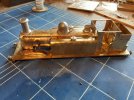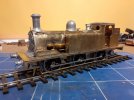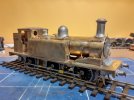Scanlon
Western Thunderer
I use the weekends to work on my own loco builds and the E1 has progressed somewhat. On the frames the large transverse air reservoir has been fitted, just pipework to add once I have positively identified routes/positions from BR period photographs.
Considerably more work has progressed on the engine body. The handrails were first added this then gave me a position from which to install the vacuum ejector pipe on the drivers side. While on the firemans side, there is a lubricating pipe to the smokebox. A start was then made on cleaning up the white metal castings. The locomotive I am building had the whistle mounted on the safety valve cover unlike most others which had it mounted on the cab roof.
While some modellers will disagree, I consider the E1 to be a Terrier on steroids! Reviewing both SR and BR period photos, and in the absence of anything to the contrary, I have used the A1X rebuild as my guide for the position of the bottle valves for the steam feeds to the injectors. As on the Terrier, BR photos show these valves to be immediately behind the dome. Also, as my E1 is a modern image build (a term coined by a fellow LB&SCR fan) the dome has been located further forward. I used an E1R diagram to assist getting the positioning correct after reference to part 2 of Bradley’s Locomotives of the LB&SCR.

Quite a lot more detailing is yet to be added, not least the smokebox door. The largest area requiring attention is the cab interior. So, with the smokebox door just put in position and the frames and cab roof added the build has reached this stage.


Lots of cleaning up to do as you can see.
Considerably more work has progressed on the engine body. The handrails were first added this then gave me a position from which to install the vacuum ejector pipe on the drivers side. While on the firemans side, there is a lubricating pipe to the smokebox. A start was then made on cleaning up the white metal castings. The locomotive I am building had the whistle mounted on the safety valve cover unlike most others which had it mounted on the cab roof.
While some modellers will disagree, I consider the E1 to be a Terrier on steroids! Reviewing both SR and BR period photos, and in the absence of anything to the contrary, I have used the A1X rebuild as my guide for the position of the bottle valves for the steam feeds to the injectors. As on the Terrier, BR photos show these valves to be immediately behind the dome. Also, as my E1 is a modern image build (a term coined by a fellow LB&SCR fan) the dome has been located further forward. I used an E1R diagram to assist getting the positioning correct after reference to part 2 of Bradley’s Locomotives of the LB&SCR.

Quite a lot more detailing is yet to be added, not least the smokebox door. The largest area requiring attention is the cab interior. So, with the smokebox door just put in position and the frames and cab roof added the build has reached this stage.


Lots of cleaning up to do as you can see.




























 ).
).




